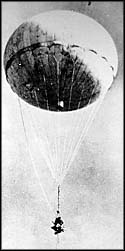
Japanese Balloon Bombs And Killed Six Picnickers In Oregon When A Balloon Bomb They Dragged From The Woods Exploded
On May 5, 1945, The U.S. Government quickly publicized the balloon bombs, warning people not to tamper with them. These were the only known fatalities occurring within the U.S. during WWII as a direct result of enemy action. Actual damage caused by the balloon bombs was minor. However, the incendiaries which they carried did pose a serious threat to the forests of the northwestern U.S. during the dry months. These balloons also offered a vehicle for germ warfare had the Japanese decided to use this weapon.
The balloon attack began after U.S. air defense facilities had been deactivated. To counter this threat, AAF and Navy fighters flew intercept missions to shoot down balloons when sighted and AAF aircraft and Army personnel were stationed at critical points to combat any forest fires which might occur. Also, supplies of decontamination chemicals and sprays to counter any possible use of germ warfare were quietly distributed in the western states. Before detailed AAF defensive plans had been put into effect, the attacks ceased.
Japanese bomb-carrying balloons were 32 feet in diameter and when fully inflated, held about 19,000 cubic feet of hydrogen. Launch sites were located on the east coast of the main Japanese island of Honshu. One of the best kept secrets of the war involved the Japanese balloon bomb offensive, prompted by the Doolittle raid on Tokyo on April 18, 1942 as a means of direct reprisal against the U.S. mainland. Some 9,000 balloons made of paper or rubberized silk and carrying anti-personnel and incendiary bombs were launched from Japan during a five-month period, to be carried by high altitude winds more than 6,000 miles eastward across the Pacific to North America.

Perhaps a thousand of these reached this continent, but there were only about 285 reported incidents. Most were reported in the northwest U.S., but some balloons traveled as far east as Michigan. The first operational launches took place on Nov. 3, 1944 and two days later a U.S. Navy patrol boat spotted a balloon floating on the water 66 miles southwest of San Pedro, California. As more sightings occurred, the government, with the cooperation of the news media, adopted a policy of silence to reduce the chance of panic among U.S. residents and to deny the Japanese any information on the success of the launches. Discouraged by the apparent failure of their effort, the Japanese halted their balloon attacks in April 1945.